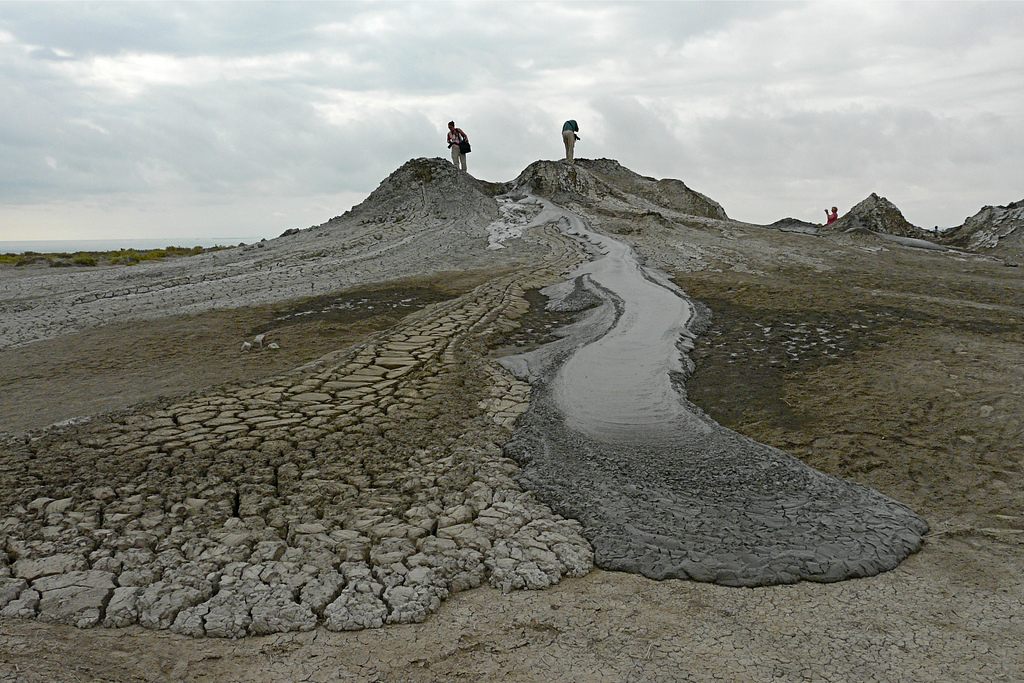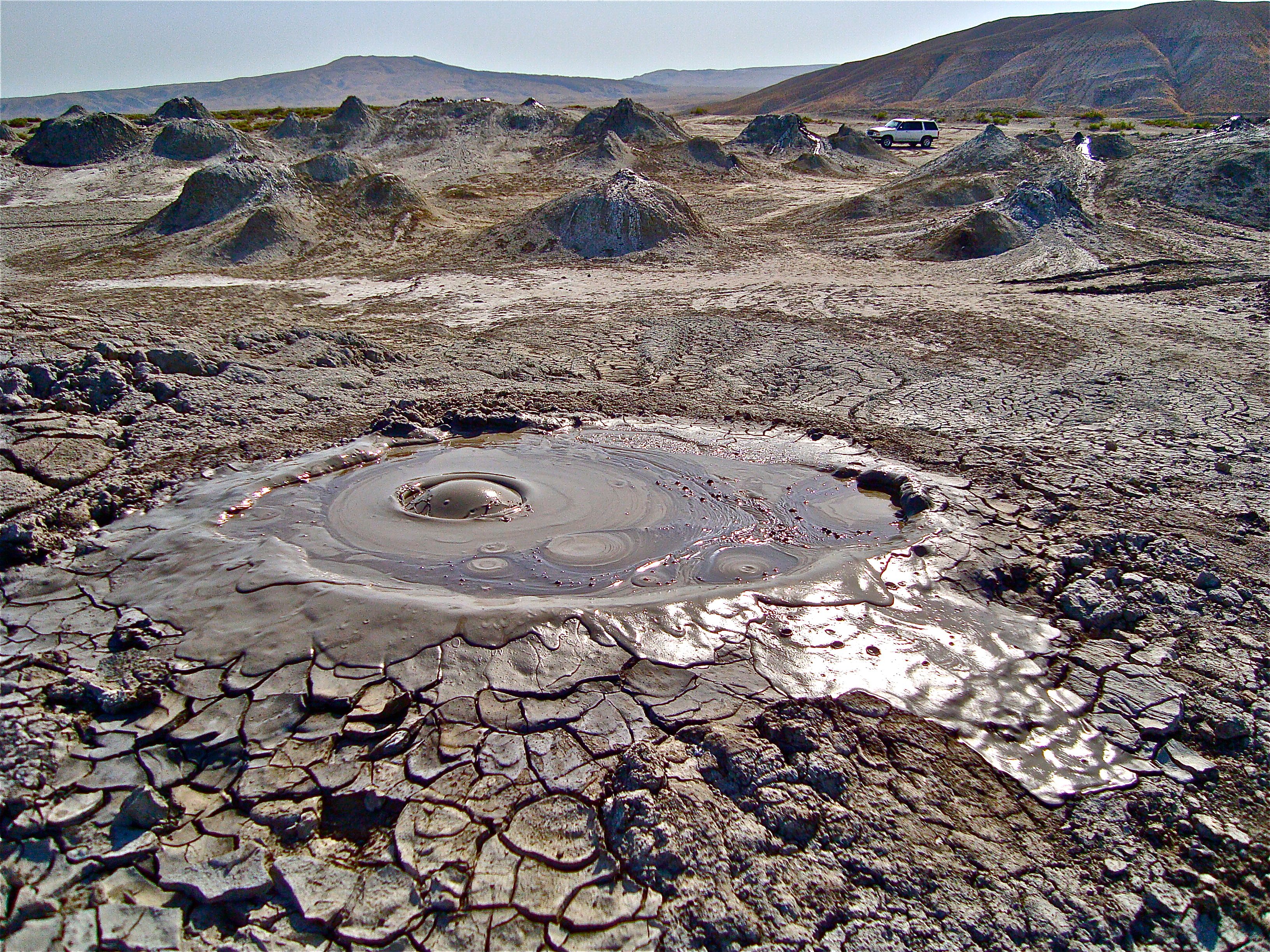Mud Volcanoes: Volcanoes But For Mud

Mud volcanoes in Azerbaijan’s Gobustan National Park. (Photo by Rita Willaert via Flickr)
Back in 2001, a spectacular volcano erupted in Azerbaijan, shooting flames 50 feet into the air.
The strange thing was: Azerbaijan is home to exactly zero active volcanoes.
But what the country does have are mud volcanoes, a funhouse-mirror relative. Mud volcanoes, caused by hot water burbling below the earth’s crust, don’t just sound dramatic: some researchers think they could be the key to understanding humanity’s past.
The size of mud volcanoes varies widely. Most are quite small, only a few feet high, though some can reach over a thousand feet. Mud volcanoes behave differently than typical volcanoes, which erupt when shifting tectonic plates allow magma to rise to the surface from deep within the earth’s crust, and pressure builds as the molten rock tries to find an escape route.
Although they are sometimes found in fault lines that are also home to regular volcanoes, mud volcanoes flare up when tectonic activity causes hot water deep underground to mix with various gases and sediments; they have nothing to do with magma.

A bubbling mud volcano in Gobastan National Park. (Photo via Atlas Obscura)
“At a certain depth, where intense gas-generation (mainly methane) takes place due to the decomposition of buried organic matter, the instability of the system becomes yet more pronounced and reaches a critical condition,” says Akper Feyzullayev, professor at the Azerbaijan National Academy of Sciences.
The amalgam creates a pressure that forces a muddy substance upwards. Mud volcanoes are more prone to seepage than explosion, though after earthquakes they’ve been known to combust, particularly in Azerbaijan. The oil-rich region along the Caspian Sea, which includes Azerbaijan, is a hotbed for mud volcanoes, with over 400, by far the most in the world.
Some islands in the Caspian Sea were formed by mud volcanoes, in the same way the Hawaiian islands were formed by regular volcanoes. Many of them are home to substantial gas and oil deposits. “There is great interest to mud volcanoes because they have direct relationship with oil and gas fields,” says Feyzullayev. “Mud volcanoes resemble super-deep exploration wells, providing valuable information on the formation and migration of oil and gas.”
Often, when a mud volcano erupts, gases like methane will burble up with the sediment and ignite when they breach the earth’s surface, causing spectacular flames. The whole region was once referred to as the “Land of Fire,” which Azerbaijan now uses as tourism motto.
A mud volcano erupting near Baku, Azerbaijan. (Video by Nijat Askerov via Youtube)
Ronnie Gallagher, a researcher who has worked with BP and Abu Dhabi’s national energy company, TAQA, has a deep fascination with mud volcanoes, partly from his work with energy companies, but partly because he thinks they might be the key to some of the most momentous times in human history. Mud volcanoes are comparatively soft, so they can be used to monitor water levels throughout recent history. In fact, research of that sort has been undertaken right here in the U.S., near the Salton Sea in California. Gallagher has been working for years on a theory that the draining of the Black Sea around 10,000 years ago could have led to a huge migration away from the Caucasus, and into the Middle East.
“There is evidence to suggest that the earliest settlers in the Nile Valley—Badarian and Naqada cultures—had their origins in the Caucasus region,” he emails. Yep: he thinks the ancient Egyptians may have been, at least in part, immigrants from the Caucasus.
Gallagher’s fascination with mud volcanoes isn’t unique; people throughout history have been amazed by the spurts of sediment and fire that erupt seemingly at random from the earth and sea. Feyzullayev listed for me the various terms different countries and peoples have for the mud volcanoes, ranging from blevak (“puker” in the Crimea) to parsu-gel (“foaming lake” in Turkmenistan) to gainarja (“boiling place” in Azerbaijan). Mud baths are part of traditional healing practices in the region, especially in Georgia and Azerbaijan, in a sort of “if the world gives you lemons” use of exploding gas and mud. Some people believe that the flames of the mud volcanoes are connected to the appearance of the Zoroastrian religion in Azerbaijan some 2,000 years ago.
Mud volcanoes are even suspected to exist on Mars. Researchers hold out hope that life, or evidence of past life, on the Red Planet could be found within the gurgling liquid mass of Martian mud volcanoes.
 Mud volcanoes in Gobustan National Park. (Photo by Nick Taylor via Flickr)
Mud volcanoes in Gobustan National Park. (Photo by Nick Taylor via Flickr)

Mud volcanoes in Gobustan National Park. (Photo by Y Nakanishi via Flickr)





Follow us on Twitter to get the latest on the world's hidden wonders.
Like us on Facebook to get the latest on the world's hidden wonders.
Follow us on Twitter Like us on Facebook